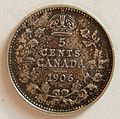| Year | Mintage [3] [4] | Notes |
|---|
| 1858 | 1,500,000 | This figure includes the small date, and large date over small date varieties. |
| 1870 | 2,800,000 | This figure includes the "Flat rim" and "Wire rim" varieties. |
| 1871 | 1,400,000 | Two different varieties have a 1 over 1 and 7 over 7 in the date. |
| 1872 H | 2,000,000 | The "H" on the coin refers to "Ralph Heaton & Sons". |
| 1874 H | 800,000 | This figure includes the "Plain 4" and "Crosslet 4" varieties. |
| 1875 H | 1,000,000 | This figure includes the small and large date varieties. |
| 1880 H | 3,000,000 | |
| 1881 H | 1,500,000 | |
| 1882 H | 1,000,000 | |
| 1883 H | 600,000 | |
| 1884 | 200,000 | Key date, lowest mintage of the Victorian and Edwardian eras. |
| 1885 | 1,000,000 | This figure includes the "small 5", "large 5", and " large 5 over small 5" varieties. |
| 1886 | 1,700,000 | This figure includes the "small" and "large 6" varieties. |
| 1887 | 500,000 | Includes a "7 over 7" date variety. |
| 1888 | 1,000,000 | |
| 1889 | 1,200,000 | |
| 1890 H | 1,000,000 | |
| 1891 | 1,800,000 | |
| 1892 | 860,000 | |
| 1893 | 1,700,000 | |
| 1894 | 500,000 | No coins were minted in 1895. |
| 1896 | 1,500,000 | |
| 1897 | 1,319,283 | Varieties include a "wide" and "narrow" 8, and a "narrow 8 over a wide 8" in the date. |
| 1898 | 580,717 | |
| 1899 | 3,000,000 | |
| 1900 | 1,800,000 | This figure includes the "Oval" and "Round 0's" varieties. |
| 1901 Victoria | 2,000,000 | |
| 1902 Edward VII | 2,120,000 | |
| 1902 H | 2,200,000 | This figure includes the "large broad" and "small narrow" H varieties. |
| 1903 | 1,000,000 | |
| 1903 H | 2,640,000 | |
| 1904 | 2,400,000 | |
| 1905 | 2,600,000 | Varieties include a "wide" and "narrow" date and a 5 over 5. |
| 1906 | 3,100,000 | Varieties include a "wide" and "narrow" date and a "low 6". |
| 1907 | 5,200,000 | Varieties include a "wide" and "narrow" date and a "low 7". |
| 1908 | 1,220,524 | Varieties include a "small" and "large" 8 in the date. |
| 1909 | 1,983,725 | This figure includes the "round/rounded" and "pointed" leaves varieties. |
| 1910 | 3,850,325 | This figure includes the "round/rounded" and "pointed" leaves varieties. |























